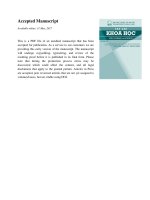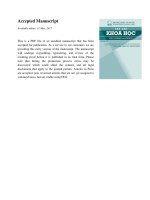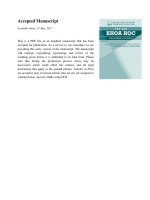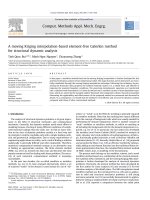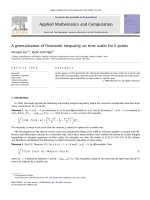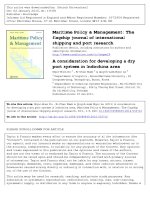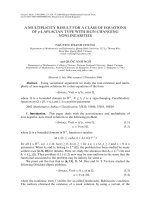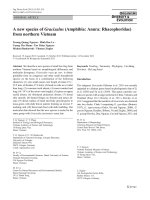DSpace at VNU: A Fuzzy MCDM Approach for Green Supplier Selection from the Economic and Environmental Aspects
Bạn đang xem bản rút gọn của tài liệu. Xem và tải ngay bản đầy đủ của tài liệu tại đây (1.91 MB, 11 trang )
Hindawi Publishing Corporation
Mathematical Problems in Engineering
Volume 2016, Article ID 8097386, 10 pages
/>
Research Article
A Fuzzy MCDM Approach for Green Supplier Selection from
the Economic and Environmental Aspects
Hsiu Mei Wang Chen,1 Shuo-Yan Chou,1 Quoc Dat Luu,2 and Tiffany Hui-Kuang Yu3
1
Department of Industrial Management, National Taiwan University of Science and Technology, No. 43, Section 4,
Keelung Road, Da’an District, Taipei 10607, Taiwan
2
University of Economics and Business, Vietnam National University, 144 Xuan Thuy, Hanoi, Vietnam
3
Department of Public Finance, Feng Chia University, Taichung, Taiwan
Correspondence should be addressed to Hsiu Mei Wang Chen;
Received 22 October 2015; Revised 26 January 2016; Accepted 31 January 2016
Academic Editor: Young Hae Lee
Copyright © 2016 Hsiu Mei Wang Chen et al. This is an open access article distributed under the Creative Commons Attribution
License, which permits unrestricted use, distribution, and reproduction in any medium, provided the original work is properly
cited.
Due to the challenge of rising public awareness of environmental issues and governmental regulations, green supply chain
management (SCM) has become an important issue for companies to gain environmental sustainability. Supplier selection is
one of the key operational tasks necessary to construct a green SCM. To select the most suitable suppliers, many economic and
environmental criteria must be considered in the decision process. Although numerous studies have used economic criteria such
as cost, quality, and lead time in the supplier selection process, only some studies have taken into account the environmental issues.
This study proposes a comprehensive fuzzy multicriteria decision making (MCDM) approach for green supplier selection and
evaluation, using both economic and environmental criteria. In the proposed approach, a fuzzy analytic hierarchy process (AHP)
is employed to determine the important weights of criteria under vague environment. In addition, a fuzzy technique for order
performance by similarity to ideal solution (TOPSIS) is used to evaluate and rank the potential suppliers. Finally, a case study in
Luminance Enhancement Film (LEF) industry is presented to illustrate the applicability and efficiency of the proposed method.
1. Introduction
The change of climate and the escalation in global warming have driven increasing worldwide concern about the
environmental protection. To gain and retain competitive
advantages in the global market, firms have started to focus
on the development of green products to satisfy customer
environmental needs and requirements [1]. Consequently,
green supply chain management (SCM) development with
environmental thinking and strategies has become an important task for firms [2].
Green supplier selection is a critical activity because the
environmental performance of the supply chain is affected
significantly by its constituent supplier [3, 4]. Environmental
and economic dimensions must be considered simultaneously when firms select a suitable supplier [5]. The green
suppliers are chosen and must fit a firm’s expectations and
objectives, so as to minimize negative environmental impact
and maximize economic performance. Thus, the green supplier selection process integrates environmental concerns
into the interorganizational practices of SCM including
reverse logistics [6].
Despite the growing work of green SCM, however, existent researches generally concentrate mainly on decision
making techniques with complicated mathematical computational models in supplier selection problem. In addition, consider environmental aspects in isolated way [7]. The implementation of green supply management is not well understood, and understanding the environmental sustainability
practices involving SCM activities is still limited [8]. Therefore, more researches are needed to answer how companies
actually carry out green supplier selection [9] considering
environmental and economic aspects simultaneously.
In recent years, TOPSIS (technique for order performance by similarity to ideal solution), proposed by Shih et al.
[10], has been a popular technique to solve MCDM problems.
2
The fundamental idea of TOPSIS is that the chosen alternative
should have the shortest Euclidian distance from the positiveideal solution and the farthest distance from the negativeideal solution. The positive-ideal solution is a solution that
maximizes the benefit criteria and minimizes the cost criteria,
whereas the negative ideal solution maximizes the cost
criteria and minimizes the benefit criteria. In the classical
TOPSIS method, the weights of the criteria and the ratings
of alternatives are known precisely, and crisp values are used
in the evaluation process. Under many circumstances, however, crisp data are inadequate to simulate real-life decision
problems. Consequently, a fuzzy TOPSIS method is proposed
to deal with the deficiency in the traditional TOPSIS. The
method based on the weights of criteria and ratings of alternatives are evaluated by linguistic variables represented by fuzzy
numbers. Some advantages of the TOPSIS [11] and fuzzy
TOPSIS method include the following: (i) a sound logic that
embodies rational human choice; (ii) a simple computation
process that can be used and programmed easily; (iii) the
number of steps that remains the same regardless of the
number of attributes; (iv) a scalar value that accounts for both
the best and worst alternatives at the same time. As a result,
fuzzy TOPSIS approach has been broadly applied to decisionmaking applications over the past few decades.
Several studies in the literature have mentioned the
difficulty of weighting the criteria and keeping consistency of
judgment when using fuzzy TOPSIS. Thus, the combination
of the fuzzy TOPSIS with another method, such as fuzzy
analytic hierarchy process (AHP), might be able to determine
proper objective weightings under a vague environment. The
AHP, a powerful tool in applying MCDA, was introduced
and developed by B¨uy¨uk¨ozkan and C
¸ ifc¸i [12]. The AHP helps
identify the weights or priority vector of the alternatives or the
criteria, using a hierarchical model that includes target, main
criteria, subcriteria, and alternatives. Nevertheless, a major
disadvantage of AHP is that it is unable to handle adequately
the inherent uncertainty and imprecision of human thinking.
Fuzzy AHP has been developed to solve this problem [13]. In
FAHP method, the application of the fuzzy comparison ratio
tolerates vagueness in the model. Decision makers use natural
linguistic emphasis as well as certain numbers to evaluate
criteria and alternatives. Fuzzy AHP impressively resembles
human thought and perception. In the literature, many
studies have used either fuzzy TOPSIS or fuzzy AHP methods
to select and evaluate the suppliers [14–19]. However, few
studies have proposed an integrated fuzzy MCDM approach
for suppliers selection and evaluation, especially in the case
of green suppliers.
This paper proposes an integrated fuzzy multicriteria
decision making (MCDM) approach, to solve problems
of green supplier selection and supply chain construction
simultaneously, effectively, and efficiently. To address the
research need, we leverage a small and medium sized high
tech company to draw a case study of an actual green
supplier selection and green SCM experience of a Taiwanese
optical prism manufacturing entity (hereinafter referred to
as TOP, a pseudonym), in the Luminance Enhancement
Film (LEF) industry. The company was selected because the
rapidly changing environment of the optical prism industry
Mathematical Problems in Engineering
forces firm to develop ongoing sustainable capabilities and to
respond to the uncertain environment.
The remainder of this paper is organized as follows. In
Section 2 green supplier selection criteria and method literature is reviewed. The basic concepts of fuzzy numbers are
shown in Section 3. The integrated fuzzy MCDM approach
is proposed in Section 4. Section 5 applies the proposed
approach to a real case. Concluding remarks are presented in
Section 6.
2. Literature Review on Green Supplier
Selection Criteria and Methods
As a result of escalated global warming and increasing environmental protection awareness, EU environmental orders
such as RoHS, WEEE, ErP, and REACH have been enforced.
The supply chains of firm and the products are required
to become more ecofriendly, especially in the electronics
industry. The circumstance has driven supply chains not only
to comply with environmental policies but also to enforce
firms govern their own corporate environmental policies to
sustain in the global market.
Green SCM has become a strategy to improve a firm’s
environmental and economic performance [25, 38]. Procurement constitutes one of the key strategic functions in SCM.
Selecting the right supplier gives the firm a competitive edge
to either reduce costs, enhance the quality [39], or minimize
negative environmental impact, avoiding violating relevant
legislation [20].
In practice, when a firm is purchasing, the professional
purchaser chooses the favorite suppliers on the basis of
specifications and conditions. A firm primarily prioritizes
economic criteria such as cost, quality, delivery, and flexibility. The environmental certificate of ISO 14000, as one of environmental criteria, is usually applied for purchaser reference
only. Efficient evaluation criteria can help the firm to reduce
the risks associated with suppliers [21]. Current literatures
address the most popular economic criteria considered by the
decision makers for supplier selection and evaluation which
are quality [4, 12, 22, 23, 25], cost [20–24], delivery [21, 23, 26,
27], flexibility [22, 28, 29], and relationship [23, 28, 29]. Environmental criteria are environmental management system
[2, 19, 28, 32–34, 36, 37], green competencies [2, 33, 34, 36, 37],
and ecodesign [28, 32, 34, 35]. Few studies simultaneously
considered economic and environmental aspects for green
supplier selection.
Currently, environmental factors play a vital role for the
long term success of a supply chain, and the purchasing
process has become more complicated with environmental
consideration [3]. Several studies have examined the criteria
of supplier selection and focused on different approaches or
criteria. Table 1 presents the most commonly used criteria
in the literature to evaluate the environmental and economic
performance of green supplier selection.
In the literature, numerous techniques have been developed to select the most suitable suppliers or green suppliers
based on specific methods including fuzzy AHP [3, 40–43],
analytic network process (ANP) [6, 29], data envelopment
analysis (DEA) [6], MCDM approach [13, 21, 31, 33, 44–47],
Mathematical Problems in Engineering
3
Table 1: Green supplier selection and evaluation criteria.
Criteria
References
Subcriteria
Sub-subcriteria/definition
Cost
Product price, logistics cost, and payment terms
ISO quality system installed, quality award, product performance,
warranties and claim policies, and repair and return rate
Lead time, on-time delivery, safety and security of components, and
appropriateness of the packaging
Communication and e-commerce systems, capability of research
development and innovation, and production facilities and capacity
Product volume changes, short setup time, conflict resolution, using
flexible machines, the demand that can be profitably sustained, and
time or cost required to add new products to the existing production
operation
Quality
Delivery
Technology
Economic criteria
Flexibility
Financial
capability
Culture
Innovativeness
Relationship
Pollution
production
Pollution
control
Resource
consumption
Ecodesign
Environmental
management
system
Environmental criteria Green image
Green
competencies
Green product
Staff
environmental
training
Management
commitment
Green
Technology
[20–24]
[4, 12, 22, 23, 25]
[21, 23, 26, 27]
[22, 23, 26]
[22, 28, 29]
Financial position, economical stability, and price strategy
[12, 23, 30]
Communication openness, vendor’s image, and mutual trust
New launch of products and new launch of technologies
Long term relationship, relationship closeness, communication
openness, and reputation for integrity
Average volume of air pollutants, waste water, solid waste, and
harmful materials released
[20, 23, 27]
[31]
Remediation and end-of-pipe controls
Consumption of resources in terms of raw material, energy, and water
[23, 28, 29]
[19, 22, 32]
[2, 19, 33]
[19, 32]
Design for resource efficiency, design of products for reuse, recycle,
[28, 32, 34, 35]
and recovery of material, design for reduction, or elimination of
hazardous materials
Environmental certificates such as ISO 14000, continuous monitoring
[2, 19, 28, 32–34, 36, 37]
and regulatory compliance, environmental policies, green process
planning, and internal control process
[2, 33, 35]
Ratio of green customers to total customers and social responsibility
Materials used in the supplied components that reduce the impact on
[2, 33, 34, 36, 37],
natural resources and ability to alter process and product for reducing
the impact on natural resources
Use of recycled and nontoxic materials, green packaging, and excess
[6, 34, 36]
packaging reduction
Staff training on environmental issues
Commitment of senior managers to support and improve green
supply chain management initiatives
The application of the environmental science to conserve the natural
environment and resources and to curb the negative impact of human
involvement
structural equation modeling and fuzzy logic [23], optimum
mathematical planning model [35], linguistic preferences
[28], fuzzy linguistic computing approach [27], Fuzzy Adaptive Resonance Theory algorithm [30], and genetic algorithm
(GA) [48].
Although a number of methods have been studied,
most of the studies have only used either economic or
environmental criteria for evaluating the suppliers. There
are few studies considering economic and environmental
criteria simultaneously in the supplier selection process.
[36]
[34, 36]
[6, 34]
And each of those methods has its own advantages and
disadvantages; this study proposes the integrated approach
by combining the two most popular techniques for solving
green supplier problems, that is, fuzzy TOPSIS and fuzzy
AHP. In the proposed approach, the fuzzy AHP is employed
to determine the important weights of criteria under vague
environment. Then, the fuzzy TOPSIS is used to evaluate and
rank the potential suppliers. In addition, both economic and
environmental criteria are considered in proposed MCDM
approach.
4
Mathematical Problems in Engineering
3. Fuzzy Numbers
There are various ways to define fuzzy numbers. This paper
defines the concept of fuzzy numbers as follows [49, 50].
Definition 1. A real fuzzy number 𝐴 is described as any fuzzy
subset of the real line 𝑅 with membership function 𝑓𝐴, which
has the following properties:
By the interval arithmetic, some main operations of 𝐴 and 𝐵
can be expressed as follows [50]:
(𝐴 ⊕ 𝐵)𝛼 = [𝐴𝛼𝑙 + 𝐵𝑙𝛼 , 𝐴𝛼𝑢 + 𝐵𝑢𝛼 ] ,
(𝐴 ⊖ 𝐵)𝛼 = [𝐴𝛼𝑙 − 𝐵𝑢𝛼 , 𝐴𝛼𝑢 − 𝐵𝑙𝛼 ] ,
(𝐴 ⊗ 𝐵)𝛼 = [𝐴𝛼𝑙 ⋅ 𝐵𝑙𝛼 , 𝐴𝛼𝑢 ⋅ 𝐵𝑢𝛼 ] ,
(a) 𝑓𝐴 is a continuous mapping from 𝑅 to the closed
interval [0, 1].
𝐴𝛼 𝐴𝛼
(𝐴 ⊘ 𝐵)𝛼 = [ 𝛼𝑙 , 𝛼𝑢 ] ,
𝐵𝑢 𝐵𝑙
(b) 𝑓𝐴(𝑥) = 0, for all 𝑥 ∈ (−∞, 𝑎].
(𝐴 ⊗ 𝑟)𝛼 = [𝐴𝛼𝑙 ⋅ 𝑟, 𝐴𝛼𝑢 ⋅ 𝑟] ,
(c) 𝑓𝐴 is strictly increasing on [𝑎, 𝑏].
(d) 𝑓𝐴(𝑥) = 1, for all 𝑥 ∈ [𝑏, 𝑐];
(f) 𝑓𝐴(𝑥) = 0, for all 𝑥 ∈ (𝑑, ∞],
where 𝑎, 𝑏, 𝑐, and 𝑑 are real numbers. Unless elsewhere
specified, this research assumes that 𝐴 is convex and bounded
(i.e., −∞ < 𝑎, 𝑑 < ∞).
Definition 2. The fuzzy number 𝐴 = [𝑎, 𝑏, 𝑐, 𝑑] is a trapezoidal fuzzy number if its membership function is given by
𝐿
𝑎 ≤ 𝑥 ≤ 𝑏,
𝑏 ≤ 𝑥 ≤ 𝑐,
𝑐 ≤ 𝑥 ≤ 𝑑,
In this section, an approach for green supplier selection by
combining fuzzy TOPSIS and fuzzy AHP method is presented. The proposed approach offers a new way to solve the
green supplier selection problem effectively and efficiently,
since it enables decision makers to minimize the negative
environmental impact of the supply chain while simultaneously maximizing business performance. The procedure of
the proposed approach is stated as follows.
Step 1. Identify a number of economic and environmental
criteria.
(1)
Step 2. Aggregate the important weights of the criteria.
otherwise,
Step 3. Aggregate the ratings of suppliers versus the criteria.
where 𝑓𝐴𝐿 (𝑥) and 𝑓𝐴𝑅 (𝑥) are the left and right membership
functions of 𝐴, respectively [50].
When 𝑏 = 𝑐, the trapezoidal fuzzy number is reduced
to a triangular fuzzy number and can be denoted by 𝐴 =
(𝑎, 𝑏, 𝑑). Thus, triangular fuzzy numbers are special cases of
trapezoidal fuzzy numbers.
Definition 3 (the distance between fuzzy triangular numbers).
Let 𝐴 = (𝑎1 , 𝑏1 , 𝑑1 ) and 𝐵 = (𝑎2 , 𝑏2 , 𝑑2 ) be two triangular fuzzy
numbers. The distance between them is given using the vertex
method by
1
2
2
2
𝑑 (𝐴, 𝐵) = √ [(𝑎1 − 𝑎2 ) + (𝑏1 − 𝑏2 ) + (𝑑1 − 𝑑2 ) ].
3
𝑟 ∈ 𝑅+ .
4. Proposed Approach for
Green Suppliers Selection
(e) 𝑓𝐴 is strictly decreasing on [𝑐, 𝑑].
𝑓𝐴 (𝑥) ,
{
{
{
{
{
{
{1,
𝑓𝐴 (𝑥) = {
{
{
𝑓𝐴𝑅 (𝑥) ,
{
{
{
{
{0,
(4)
(2)
Definition 4 (𝛼-cuts). The 𝛼-cuts of fuzzy number 𝐴 can be
defined as 𝐴𝛼 = {𝑥 | 𝑓𝐴(𝑥) ≥ 𝛼}, 𝛼 ∈ [0, 1], where 𝐴𝛼
is a nonempty bounded closed interval contained in 𝑅 and
can be denoted by 𝐴𝛼 = [𝐴𝛼𝑙 , 𝐴𝛼𝑢 ], where 𝐴𝛼𝑙 and 𝐴𝛼𝑢 are its
lower and upper bounds, respectively [50]. For example, if a
triangular fuzzy number 𝐴 = (𝑎, 𝑏, 𝑑), then the 𝛼-cuts of 𝐴
can be expressed as follows:
Step 4. Normalize the fuzzy decision matrix.
Step 5. Construct the weighted normalized fuzzy decision
matrix.
Step 6. Calculate normalized weighted rating.
Step 7. Calculate 𝐴+ , 𝐴− , 𝑑𝑖+ , and 𝑑𝑖− .
Step 8. Obtain the closeness coefficient.
Assume that a committee of 𝑙 decision makers (𝐷𝑡 , 𝑡 = 1 ∼
𝑙) is responsible for evaluating 𝑚 suppliers (𝐴 𝑖 , 𝑖 = 1 ∼ 𝑚)
under 𝑛 selected criteria (𝐶𝑗 , 𝑗 = 1 ∼ 𝑛), where the suitability
ratings of alternatives under each of the criteria, as well as the
weights of the criteria, are assessed in linguistic terms [51, 52]
represented by triangular fuzzy numbers.
(3)
4.1. Identify a Number of Economic and Environmental
Criteria. In this study, the criteria are classified into two
categories, that is, economic criteria (𝐶𝑗 , 𝑗 = 1, . . . , 𝑙) and
environmental criteria (𝐶𝑗 , 𝑗 = 𝑙 + 1, . . . , 𝑛). The number of
economic and environmental criteria is selected from Table 1
through screening by the decision makers.
Definition 5 (arithmetic operations on fuzzy numbers).
Given fuzzy numbers 𝐴 and 𝐵, where 𝐴, 𝐵 ∈ 𝑅+ , the 𝛼-cuts
of 𝐴 and 𝐵 are 𝐴𝛼 = [𝐴𝛼𝑙 , 𝐴𝛼𝑢 ] and 𝐵𝛼 = [𝐵𝑙𝛼 , 𝐵𝑢𝛼 ], respectively.
4.2. Aggregate the Important Weights of the Criteria. In this
section, a fuzzy AHP is applied to obtain more decisive
judgments by prioritizing the economic and environmental
𝐴𝛼 = [𝐴𝛼𝑙 , 𝐴𝛼𝑢 ] = [(𝑏 − 𝑎) 𝛼 + 𝑎, (𝑏 − 𝑑) 𝛼 + 𝑑] .
Mathematical Problems in Engineering
5
criteria. Several fuzzy AHP methods have been proposed in
literature to solve the MCDM problems. This study adopts
the extent analysis method proposed by Chang [53] due
to its popularity and computational simplicity. Chang’s [53]
method is briefly discussed as follows.
Let 𝑋 = {𝑥1 , 𝑥2 , . . . , 𝑥𝑛 } be an object set and let 𝑈 =
{𝑢1 , 𝑢2 , . . . , 𝑢𝑚 } be a goal set. According to Chang [53], each
object is taken and an extent analysis for each goal (𝑔𝑖 )
is performed, respectively. Therefore, the 𝑚 extent analysis
values for each object are obtained as 𝑀𝑔1𝑖 , 𝑀𝑔2𝑖 , . . . , 𝑀𝑔𝑛𝑖 , 𝑖 =
1, 2, . . . , 𝑛, where 𝑀𝑔𝑗 𝑖 (𝑗 = 1, 2, . . . , 𝑚) are triangular fuzzy
numbers (TFNs).
Assume that 𝑀𝑔𝑗 𝑖 are the values of extent analysis of the
𝑖th object for 𝑚 goals. The value of fuzzy synthetic extent 𝑆𝑖 is
defined as follows:
𝑆𝑖 =
∑𝑚
𝑗=1
𝑚
∑ 𝑀𝑔𝑗 𝑖
𝑗=1
⊗
𝑛
−1
𝑚
[∑ ∑ 𝑀𝑗 ]
𝑔𝑖
𝑖=1 𝑗=1
[
,
(5)
]
where
=
𝑚𝑗 , ∑𝑚
𝑗=1 𝑢𝑗 ), 𝑗 = 1, 2,
. . . , 𝑚, 𝑖 = 1, 2, . . . , 𝑛.
Let 𝑀1 = (𝑙1 , 𝑚1 , 𝑢1 ) and 𝑀2 = (𝑙2 , 𝑚2 , 𝑢2 ) be two TFNs,
whereby the degree of possibility of 𝑀1 ≥ 𝑀2 is defined as
follows:
𝑀𝑔𝑗 𝑖
𝑚
(∑𝑚
𝑗=1 𝑙𝑗 , ∑𝑗=1
𝑉 (𝑀1 ≥ 𝑀2 ) = sup [min (𝜇𝑀1 (𝑥) , 𝜇𝑀2 (𝑥))] .
𝑥≥𝑦
(6)
The membership degree of possibility is expressed as follows:
𝑉 (𝑀1 ≥ 𝑀2 ) = hgt (𝑀1 ∩ 𝑀2 ) = 𝜇𝑀2 (𝑑)
1
{
{
{
{
{
= {0
{
{
𝑙2 − 𝑢1
{
{
{ (𝑙2 − 𝑢1 ) + (𝑚1 − 𝑚2 )
if 𝑚1 ≥ 𝑚2
if 𝑙2 ≥ 𝑢1
(7)
otherwise,
where 𝑑 is the ordinate of the highest intersection point of
two membership functions 𝜇𝑀1 (𝑥) and 𝜇𝑀2 (𝑥).
The degree of possibility for a convex fuzzy number to be
greater than 𝑘 convex fuzzy numbers is defined as follows:
𝑉 (𝑀 ≥ 𝑀1 , 𝑀2 , . . . , 𝑀𝑘 ) = min 𝑉 (𝑀 ≥ 𝑀𝑖 ) ,
𝑖 = 1, 2, . . . , 𝑘.
(8)
4.3. Aggregate the Ratings of Suppliers versus the Criteria. Let
𝑥𝑖𝑗𝑡 = (𝑒𝑖𝑗𝑡 , 𝑓𝑖𝑗𝑡 , 𝑔𝑖𝑗𝑡 ), 𝑖 = 1 ∼ 𝑚, 𝑗 = 1 ∼ 𝑛, 𝑡 = 1 ∼ 𝑙, be the
suitability rating assigned to green supplier 𝐴 𝑖 , by decision
maker 𝐷𝑡 , for criterion 𝐶𝑗 . The averaged suitability rating,
𝑥𝑖𝑗 = (𝑒𝑖𝑗 , 𝑓𝑖𝑗 , 𝑔𝑖𝑗 ), can be evaluated as follows:
𝑥𝑖𝑗 =
1
⊗ (𝑥𝑖𝑗1 ⊕ 𝑥𝑖𝑗2 ⊕ ⋅ ⋅ ⋅ ⊕ 𝑥𝑖𝑗𝑡 ⊕ ⋅ ⋅ ⋅ ⊕ 𝑥𝑖𝑗𝑙 ) ,
𝑙
where 𝑒𝑖𝑗 = (1/𝑙) ∑𝑙𝑡=1 𝑒𝑖𝑗𝑡 , 𝑓𝑖𝑗 = (1/𝑙) ∑𝑙𝑡=1 𝑓𝑖𝑗𝑡 , and 𝑔𝑖𝑗 =
(1/𝑙) ∑𝑙𝑡=1 𝑔𝑖𝑗𝑡 .
4.4. Normalize Performance of Suppliers versus Criteria. To
ensure compatibility between average ratings and average
weights, the average ratings are normalized into comparable
scales. Suppose that 𝑟𝑖𝑗 = (𝑎𝑖𝑗 , 𝑏𝑖𝑗 , 𝑐𝑖𝑗 ) is the performance of
green supplier 𝑖 on criteria 𝑗. The normalized value 𝑥𝑖𝑗 can
then be denoted as follows:
𝑥𝑖𝑗 = (
𝑎𝑖𝑗 𝑏𝑖𝑗 𝑐𝑖𝑗
, , ) , 𝑗 ∈ 𝐵,
𝑐𝑗∗ 𝑐𝑗∗ 𝑐𝑗∗
𝑎𝑗− 𝑎𝑗− 𝑎𝑗−
𝑥𝑖𝑗 = ( , , ) ,
𝑐𝑖𝑗 𝑏𝑖𝑗 𝑎𝑖𝑗
𝑇
𝑊 = (𝑑 (𝐴 1 ) , 𝑑 (𝐴 2 ) , . . . , 𝑑 (𝐴 𝑛 )) ,
where 𝑎𝑗− = min𝑖 𝑎𝑖𝑗 , 𝑐𝑗∗ = max𝑖 𝑐𝑖𝑗 , 𝑖 = 1, . . . , 𝑚, and 𝑗 =
1, . . . , 𝑛.
4.5. Calculate Normalized Weighted Rating. The normalized
weighted ratings 𝐺𝑖 are calculated by multiplying the normalized average rating 𝑥𝑖𝑗 with its associated weights 𝑤𝑗𝑡 as
follows:
𝐺𝑖 = 𝑥𝑖𝑗 ⊗ 𝑤𝑗 ,
𝑖 = 1, . . . , 𝑚, 𝑗 = 1, . . . , ℎ.
(𝑖 = 1, 2, . . . , 𝑛) , 𝑘 = 1, 2, . . . , 𝑛; 𝑘 ≠ 𝑖.
4.6. Calculate 𝐴+ , 𝐴− , 𝑑𝑖+ , and 𝑑𝑖− . The fuzzy positiveideal solution (FPIS, 𝐴+ ) and fuzzy negative-ideal solution
(FNIS, 𝐴− ) are obtained as follows:
𝐴+ = (1.0, 1.0, 1.0) ,
𝑇
(15)
The distance of each green supplier 𝐴 𝑖 , 𝑖 = 1, . . . , 𝑚, from 𝐴+
and 𝐴− is calculated as follows:
(10)
𝑑𝑖+ = √ ∑ (𝐺𝑖 − 𝐴+ ) ,
𝑛
2
𝑖=1
(16)
Via normalization, we obtain the weight vectors as follows:
𝑊 = (𝑑 (𝐴 1 ) , 𝑑 (𝐴 2 ) , . . . , 𝑑 (𝐴 𝑛 )) ,
(14)
(9)
where
𝑑 (𝐴 𝑖 ) = min 𝑉 (𝑆𝑖 ≥ 𝑆𝑘 ) ,
(13)
𝑗 ∈ 𝐶,
𝐴− = (0.0, 0.0, 0.0) .
The weight vector is given by
(12)
(11)
where 𝑊 is a nonfuzzy number.
This study adopts a “Likert Scale” of fuzzy numbers
starting from 1 to 9 to transform the linguistic values into
triangular fuzzy numbers, as shown in Table 2.
𝑛
2
𝑑𝑖− = √ ∑ (𝐺𝑖 − 𝐴− ) ,
𝑖=1
where 𝑑𝑖+ represents the shortest distance of alternative 𝐴 𝑖
and 𝑑𝑖− represents the farthest distance of green supplier 𝐴 𝑖 .
6
Mathematical Problems in Engineering
Table 2: Linguistic variables describing weights of the “HOWs” criteria.
Triangular fuzzy scale 𝑀 = (𝑙, 𝑚, 𝑢)
Linguistic scale for importance
Just equal
Equal importance
Weak importance
Strong importance
Very strong importance
Extremely importance
If factor 𝑖 has one of the above numbers assigned to it when compared to
factor 𝑗, then 𝑗 has the reciprocal value when compared with 𝑖
4.7. Obtain the Closeness Coefficient. The closeness coefficient
of each green supplier, which is usually defined to determine
the ranking order of all green suppliers, is calculated as
follows:
CC𝑖 =
𝑑𝑖+
𝑑𝑖−
.
+ 𝑑𝑖−
(17)
A higher value of the closeness coefficient indicates that
an alternative is simultaneously closer to PIS and further
from NIS. The closeness coefficient of each alternative is used
to determine the ranking order of all green suppliers and
indicates the best one among a set of given feasible green
suppliers.
5. Case Study
In this paper, a comprehensive green supplier selection
model is proposed by considering the important criteria in
economic and environmental aspects for evaluating green
suppliers. The proposed method is applied on the case of
the Taiwanese optical prism (TOP) manufacturing entity in
Luminance Enhancement Film (LEF) industry to solve green
suppliers selection.
TOP, founded in late 2003, is the leading optical prism
manufacturer in Taiwan. TOP focuses on advanced product
development and quality improvement. However, TOP is
now dealing with the increase in competition. Moreover, the
LCD product life cycle is very short; qualified suppliers as
TOP frequently have to provide innovative products within
a limited lead time for customers verification to meet timeto-market as well. Consequently, with the purpose of maintaining the existing customers satisfaction and attracting
new international customers to improve market share, the
selection of quality constant green suppliers for long term
cooperation is extremely essential for survival of TOP.
When TOP confirmed its role and strategy as a green
supplier, TOP needs to evaluate its core competences and
identify the gap between customer needs and consultant
suggestions. TOP then restructures the ecological environment of the industry. TOP has employed the green SCM
simultaneously considering environmental and economic
aspects to either comply with regulation or meet customer
needs. Furthermore, TOP has proactively invested both quality and environmental management system, such as quality
(1.0, 1.0, 1.0)
(1.0, 1.0, 3.0)
(1.0, 3.0, 5.0)
(3.0, 5.0, 7.0)
(5.0, 7.0, 9.0)
(7.0, 9.0, 9.0)
Reciprocals of above
𝑀1−1 ≈ (1/𝑢1 , 1/𝑚1 , 1/𝑙1 )
system of economic criteria ISO9001 and QC080000 and
environmental criteria ISO14001 and OHSAS18001. TOP has
implemented a continuous quality improvement program
and constituted an international standard as a platform to
training staffs as well as suppliers. Those activities either
save the costs of customers involved with their supplier
development program or strengthen TOP’s green brand
image.
TOP has learned and accumulated plenty of green SCM
domain knowledge and capabilities as a main supplier of
LCD supply chain through the two-stage process of the raw
material quality verification and integration all of material in
one product for each customer. Thus, TOP reversely requests
the suppliers to comply with its customer environmental and
economic requirement. Under the consensus of a multidisciplinary group of decision makers with various points of view
and representing the different services of the company, TOP’s
managers and heads of departments have decided that product price, ISO quality system, and lead time are economic
criteria. Green technology and environmental certificate are
environmental criteria. The managers of the departments
such as Employee Health and Safety, Production, Quality
Control and Assessment, and Purchasing were required to
make their evaluation, respectively.
In reality, TOP must work with suppliers for green product development. Quality control and supply ability of economic criteria are the most important customer requirement
factors which related to green products. TOP’s management
team continuously integrates resources to investigate green
products, such as light, lean production, and energy saving,
to satisfy stakeholders. TOP is keeping good relationship with
the suppliers that will benefit from the purchasing materials if
needed. Additionally, TOP also maintains good relationship
with customers who will provide TOP opportunities in
innovative product developing and meeting the needs of
customers easier.
The case revealed that the green criteria such as environment and sustainability do not yet play a crucial role within
green supplier selection procedures in enterprise practice.
Due to the environmental regulations, suppliers must meet
some minimum requirements in order to be eligible to work
with focal firms on the supply chain. After that, most of the
companies do not apply environmental criteria to discriminate qualified suppliers; instead customers require suppliers
to provide information such as Certificate of Nonuse of
Mathematical Problems in Engineering
7
Table 3: Fuzzy pairwise comparison of economic and environmental criteria.
Criteria
𝐶1
𝐶2
𝐶3
𝐶4
𝐶5
𝐶1
(1.0, 1.0, 1.0)
(1/5, 1/3, 1/1)
(1/9, 1/7, 1/5)
(1/5, 1/3, 1/1)
(1/3, 1/1, 1/1)
𝐶2
(1.0, 3.0, 5.0)
(1.0, 1.0, 1.0)
(5.0, 7.0, 9.0)
(1.0, 3.0, 5.0)
(1/9, 1/7, 1/5)
Table 4: Fuzzy weights of the economic and environmental criteria.
Criteria
𝐶1
𝐶2
𝐶3
𝐶4
𝐶5
Fuzzy weight
(0.123; 0.295; 0.699)
(0.089; 0.173; 0.371)
(0.087; 0.168; 0.330)
(0.076; 0.203; 0.456)
(0.074; 0.160; 0.371)
Controlled Substances, Certificate of Nonuse of Other Controlled Substances, Material Safety Data Sheet, and Test
Report of customer assigned items issued by SGS annually.
Those certificates concern quality of economic criterion and
pollution control of environmental criterion.
According to institutional theory, implementation of
green SCM is due to mimetic and normative (competitive
and bench marking) mechanisms. Facing environmental protection pressure and legitimacy isomorphism pressure, enterprises must comply with social expectation and maintain
consistency with external environment to survive. Thus, the
environmental and economic dimensions must be considered
simultaneously [5]. Consequently, the proposed method is
applied on the case of TOP following the steps below.
Step 1 (identify a number of economic and environmental criteria). In this study, the data used as input to implement the
proposed green supplier selection and evaluate the method
were collected by means of semistructured interviews with
the top managers and head of departments. Four company
managers were required to make their evaluation, respectively, according to their preferences for important weights
of selection criteria and ratings of green suppliers.
Using Table 1 and discussions with a company’s top managers and heads of departments, five criteria of economics
and environment for green supplier selection were selected.
Economic criteria include product price (𝐶1 ), ISO quality
system (𝐶2 ), and lead time (𝐶3 ). Green technology (𝐶4 ) and
environmental certificate (𝐶5 ) are environmental criteria.
Step 2 (aggregate the important weights of the criteria).
After the determination of the green supplier criteria, each
of four company managers is asked to conduct a pairwise
comparison with regard to the different criteria using the
fuzzy linguistic assessment variables (see Table 2 for these
variables). The completed matrices for the required cell are
shown in Table 3. Applying (5)–(8), the final weights of the
economic and environmental criteria are obtained as shown
in Table 4.
𝐶3
(5.0, 7.0, 9.0)
(1/9, 1/7, 1/5)
(1.0, 1.0, 1.0)
(3.0, 5.0, 7.0)
(3.0, 5.0, 7.0)
𝐶4
(1.0, 3.0, 5.0)
(1/5, 1/3, 1/1)
(1/7, 1/5, 1/3)
(1.0, 1.0, 1.0)
(1.0, 1.0, 3.0)
𝐶5
(1.0, 1.0, 3.0)
(5.0, 7.0, 9.0)
(1/7, 1/5, 1/3)
(1/3, 1/1, 1/1)
(1.0, 1.0, 1.0)
Step 3 (aggregate the ratings of suppliers versus the criteria).
After the determination of the suppliers assessment criteria,
four company managers rate each supplier according to each
criterion. A linguistic rating set of S was used to express the
opinions of the managers, where S = (VP, P, F, G, VG), VP
(Very Poor) = (0.0, 0.1, 0.2), P (Poor) = (0.1, 0.3, 0.5), F (Fair) =
(0.3, 0.5, 0.7), G (Good) = (0.5, 0.7, 0.9), and VG (Very Good)
= (0.8, 0.9, 1.0). Table 5 gives the aggregated suitability ratings
of four green suppliers (𝐴 1 , 𝐴 2 , 𝐴 3 , and 𝐴 4 ) using (12).
Step 4 (normalized performance of suppliers versus criteria).
For simplicity and practicality, all of the fuzzy numbers in this
paper are defined in the closed interval [0, 1]. Consequently,
the normalization procedure is no longer needed.
Step 5 (calculate normalized weighted rating). Using (14), the
normalized weighted ratings 𝐺𝑖 can be obtained as shown in
Table 6.
Step 6 (calculate 𝐴+ , 𝐴− , 𝑑𝑖+ , and 𝑑𝑖− ). As shown in Table 7,
the distance of each green supplier from 𝐴+ and 𝐴− can be
calculated by (15)∼(16).
Step 7 (obtain the closeness coefficient). The closeness coefficients of green suppliers can be calculated by (17), as shown
in Table 8. Therefore, the ranking order of the four green
suppliers is 𝐴 3 > 𝐴 4 > 𝐴 1 > 𝐴 2 . Consequently, the best
green supplier is 𝐴 3 .
6. Conclusion
While the types of industry vary, the key strategies of
green supplier selection also are changed. Nevertheless, all
industries should concern suppliers from both economic
and environmental aspects, because suppliers could influence
firms’ performance and stakeholders.
Green supplier selection is an important and complicated
MCDM problem, requiring evaluation of multiple economic
and environmental criteria incorporating vagueness and
imprecision with the involvement of a group of experts.
Although numerous studies have used economic criteria in
the supplier selection process, limited studies have considered the economic and environmental criteria simultaneously. The implementation of green supply management was
not well understood. This paper has proposed an integrated
fuzzy MCDM approach to support the green suppliers selection and the evaluation process. In the proposed approach,
both economic and environmental criteria were considered.
In order to overcome the shortcomings of the existing fuzzy
8
Mathematical Problems in Engineering
Table 5: Aggregate of the green supplier ratings versus criteria.
Criteria
Green suppliers
𝐴1
𝐴2
𝐴3
𝐴4
𝐴1
𝐴2
𝐴3
𝐴4
𝐴1
𝐴2
𝐴3
𝐴4
𝐴1
𝐴2
𝐴3
𝐴4
𝐴1
𝐴2
𝐴3
𝐴4
𝐶1
𝐶2
𝐶3
𝐶4
𝐶5
Company managers
𝐷2
𝐷3
G
G
G
G
G
G
F
G
G
G
F
G
G
VG
G
VG
F
G
F
F
G
VG
G
F
G
G
VG
G
VG
VG
G
VG
G
G
G
G
G
G
G
G
𝐷1
VG
F
G
G
G
F
G
VG
G
F
VG
F
F
G
G
VG
G
VG
G
VG
Table 6: Normalized weighted ratings of each market segment.
𝐺𝑖
(0.045, 0.138, 0.392)
(0.041, 0.129, 0.372)
(0.052, 0.151, 0.413)
(0.048, 0.143, 0.396)
Green suppliers
𝐴1
𝐴2
𝐴3
𝐴4
Table 7: The distance of each green supplier from 𝐴+ and 𝐴− .
Green suppliers
𝐴1
𝐴2
𝐴3
𝐴4
𝑑+
1.422
1.440
1.402
1.416
𝑑−
0.418
0.396
0.442
0.424
Table 8: Closeness coefficients of alternatives.
Alternatives
𝐴1
𝐴2
𝐴3
𝐴4
Closeness coefficient
0.227
0.216
0.240
0.230
Ranking
3
4
1
2
TOPSIS technique, this study has integrated the fuzzy TOPSIS technique with the fuzzy AHP method, to determine the
important weights of economic and environmental criteria.
Finally, the proposed approach was employed to solve a real
problem in the LEF industry. The results showed that the
𝐷4
VG
F
G
G
G
F
G
G
F
G
G
F
F
G
G
G
G
VG
VG
VG
𝑟𝑖𝑗
(0.650, 0.800, 0.950)
(0.400, 0.600, 0.800)
(0.500, 0.700, 0.900)
(0.450, 0.650, 0.850)
(0.500, 0.700, 0.900)
(0.350, 0.550, 0.750)
(0.575, 0.750, 0.925)
(0.650, 0.800, 0.950)
(0.400, 0.600, 0.800)
(0.350, 0.550, 0.750)
(0.650, 0.800, 0.950)
(0.350, 0.550, 0.750)
(0.400, 0.600, 0.800)
(0.575, 0.750, 0.925)
(0.650, 0.800, 0.950)
(0.650, 0.800, 0.950)
(0.500, 0.700, 0.900)
(0.650, 0.800, 0.950)
(0.575, 0.750, 0.925)
(0.650, 0.800, 0.950)
proposed approach is effective in supplier selection for the
company. The application also indicated that the computational procedure is efficient and easy to use in practice. Future
research should focus on developing an extension of fuzzy
MCDM approach to segment the green suppliers based on
the economic and environmental aspects. Different methods
may be applied to select green suppliers and the results should
be compared with the proposed approach. The proposed
approach can also be applied to other management problems
with similar settings.
Conflict of Interests
The authors declare that there is no conflict of interests
regarding the publication of this paper.
References
[1] Y.-S. Chen and C.-H. Chang, “The determinants of green product development performance: Green dynamic capabilities,
green transformational leadership, and green creativity,” Journal
of Business Ethics, vol. 116, no. 1, pp. 107–119, 2013.
[2] A. H. I. Lee, H.-Y. Kang, C.-F. Hsu, and H.-C. Hung, “A green
supplier selection model for high-tech industry,” Expert Systems
with Applications, vol. 36, no. 4, pp. 7917–7927, 2009.
[3] K. Govindan, S. Rajendran, J. Sarkis, and P. Murugesan, “Multi
criteria decision making approaches for green supplier evaluation and selection: a literature review,” Journal of Cleaner Production, vol. 98, pp. 66–83, 2015.
Mathematical Problems in Engineering
[4] R. J. Kuo, Y. C. Wang, and F. C. Tien, “Integration of artificial
neural network and MADA methods for green supplier selection,” Journal of Cleaner Production, vol. 18, no. 12, pp. 1161–1170,
2010.
[5] A. Gunasekaran and D. Gallear, “Special Issue on Sustainable
development of manufacturing and services,” International
Journal of Production Economics, vol. 140, no. 1, pp. 1–6, 2012.
[6] J. Sarkis, Q. Zhu, and K.-H. Lai, “An organizational theoretic
review of green supply chain management literature,” International Journal of Production Economics, vol. 130, no. 1, pp. 1–15,
2011.
[7] A. Appolloni, H. Sun, F. Jia, and X. Li, “Green Procurement in
the private sector: a state of the art review between 1996 and
2013,” Journal of Cleaner Production, vol. 85, pp. 122–133, 2014.
[8] H. C. Pimenta and P. D. Ball, “Analysis of environmental
sustainability practices across upstream supply chain management,” Procedia CIRP, vol. 26, pp. 677–682, 2015.
[9] C.-L. Hwang and K. Yoon, Multiple Attribute Decision Making—
Methods and Applications: A State of the Art Survey, Springer,
New York, NY, USA, 1981.
[10] H.-S. Shih, H.-J. Shyur, and E. S. Lee, “An extension of TOPSIS
for group decision making,” Mathematical and Computer Modelling, vol. 45, no. 7-8, pp. 801–813, 2007.
[11] T. L. Saaty, The Analytical Hierarchy Process, McGraw-Hill, New
York, NY, USA, 1980.
[12] G. B¨uy¨uk¨ozkan and G. C
¸ ifc¸i, “Evaluation of the green supply
chain management practices: a fuzzy ANP approach,” Production Planning and Control, vol. 23, no. 6, pp. 405–418, 2012.
[13] C.-C. Sun, “A performance evaluation model by integrating
fuzzy AHP and fuzzy TOPSIS methods,” Expert Systems with
Applications, vol. 37, no. 12, pp. 7745–7754, 2010.
[14] W. Xia and Z. Wu, “Supplier selection with multiple criteria in
volume discount environments,” Omega, vol. 35, no. 5, pp. 494–
504, 2007.
[15] I. Chamodrakas, D. Batis, and D. Martakos, “Supplier selection
in electronic marketplaces using satisficing and fuzzy AHP,”
Expert Systems with Applications, vol. 37, no. 1, pp. 490–498,
2010.
[16] K. Shaw, R. Shankar, S. S. Yadav, and L. S. Thakur, “Supplier
selection using fuzzy AHP and fuzzy multi-objective linear
programming for developing low carbon supply chain,” Expert
Systems with Applications, vol. 39, no. 9, pp. 8182–8192, 2012.
[17] O. Kilincci and S. A. Onal, “Fuzzy AHP approach for supplier
selection in a washing machine company,” Expert Systems with
Applications, vol. 38, no. 8, pp. 9656–9664, 2011.
[18] A. H. I. Lee, “A fuzzy supplier selection model with the consideration of benefits, opportunities, costs and risks,” Expert Systems with Applications, vol. 36, no. 2, pp. 2879–2893, 2009.
[19] C. Bai and J. Sarkis, “Green supplier development: analytical
evaluation using rough set theory,” Journal of Cleaner Production, vol. 18, no. 12, pp. 1200–1210, 2010.
[20] M. Abdollahi, M. Arvan, and J. Razmi, “An integrated approach
for supplier portfolio selection: lean or agile?” Expert Systems
with Applications, vol. 42, no. 1, pp. 679–690, 2015.
[21] M. S. Memon, Y. H. Lee, and S. I. Mari, “Group multi-criteria
supplier selection using combined grey systems theory and
uncertainty theory,” Expert Systems with Applications, vol. 42,
no. 21, pp. 7951–7959, 2015.
[22] S. H. Hashemi, A. Karimi, and M. Tavana, “An integrated
green supplier selection approach with analytic network process
and improved Grey relational analysis,” International Journal of
Production Economics, vol. 159, pp. 178–191, 2015.
9
[23] M. Punniyamoorthy, P. Mathiyalagan, and P. Parthiban, “A
strategic model using structural equation modeling and fuzzy
logic in supplier selection,” Expert Systems with Applications,
vol. 38, no. 1, pp. 458–474, 2011.
[24] R. M. Grisi, L. Guerra, and G. Naviglio, “Supplier performance
evaluation for green supply chain management,” in Business Performance Measurement and Management, pp. 149–163, Springer,
Berlin, Germany, 2010.
[25] F. Mafakheri, M. Breton, and A. Ghoniem, “Supplier selectionorder allocation: a two-stage multiple criteria dynamic programming approach,” International Journal of Production Economics, vol. 132, no. 1, pp. 52–57, 2011.
[26] Y.-J. Chen, “Structured methodology for supplier selection and
evaluation in a supply chain,” Information Sciences, vol. 181, no.
9, pp. 1651–1670, 2011.
[27] W.-P. Wang, “A fuzzy linguistic computing approach to supplier
evaluation,” Applied Mathematical Modelling, vol. 34, no. 10, pp.
3130–3141, 2010.
[28] M.-L. Tseng and A. S. F. Chiu, “Evaluating firm’s green supply
chain management in linguistic preferences,” Journal of Cleaner
Production, vol. 40, pp. 22–31, 2013.
[29] Q. Zhu, Y. Dou, and J. Sarkis, “A portfolio-based analysis
for green supplier management using the analytical network
process,” Supply Chain Management, vol. 15, no. 4, pp. 306–319,
2010.
¨
[30] G. A. Keskin, S. Ilhan, and C. Ozkan,
“The Fuzzy ART
algorithm: a categorization method for supplier evaluation and
selection,” Expert Systems with Applications, vol. 37, no. 2, pp.
1235–1240, 2010.
[31] C.-Y. Shen and K.-T. Yu, “Enhancing the efficacy of supplier
selection decision-making on the initial stage of new product
development: a hybrid fuzzy approach considering the strategic
and operational factors simultaneously,” Expert Systems with
Applications, vol. 36, no. 8, pp. 11271–11281, 2009.
[32] K. Govindan, R. Khodaverdi, and A. Jafarian, “A fuzzy multi
criteria approach for measuring sustainability performance of
a supplier based on triple bottom line approach,” Journal of
Cleaner Production, vol. 47, pp. 345–354, 2013.
[33] G. Tuzkaya, A. Ozgen, D. Ozgen, and U. R. Tuzkaya, “Environmental performance evaluation of suppliers: a hybrid fuzzy
multi-criteria decision approach,” International Journal of Environmental Science & Technology, vol. 6, no. 3, pp. 477–490, 2009.
[34] Q. Zhu, J. Sarkis, and K.-H. Lai, “Initiatives and outcomes of
green supply chain management implementation by Chinese
manufacturers,” Journal of Environmental Management, vol. 85,
no. 1, pp. 179–189, 2007.
[35] W.-C. Yeh and M.-C. Chuang, “Using multi-objective genetic
algorithm for partner selection in green supply chain problems,”
Expert Systems with Applications, vol. 38, no. 4, pp. 4244–4253,
2011.
[36] A. Awasthi, S. S. Chauhan, and S. K. Goyal, “A fuzzy multicriteria approach for evaluating environmental performance of
suppliers,” International Journal of Production Economics, vol.
126, no. 2, pp. 370–378, 2010.
[37] J. Sarkis, “Manufacturing’s role in corporate environmental
sustainability-Concerns for the new millennium,” International
Journal of Operations & Production Management, vol. 21, no. 56, pp. 666–686, 2001.
[38] S. M. Mirhedayatian, M. Azadi, and R. Farzipoor Saen, “A novel
network data envelopment analysis model for evaluating green
supply chain management,” International Journal of Production
Economics, vol. 147, pp. 544–554, 2014.
10
[39] C. Wu and D. Barnes, “An integrated model for green partner
selection and supply chain construction,” Journal of Cleaner
Production, vol. 112, pp. 2114–2132, 2016.
[40] G. Bruno, E. Esposito, A. Genovese, and R. Passaro, “AHP-based
approaches for supplier evaluation: problems and perspectives,”
Journal of Purchasing and Supply Management, vol. 18, no. 3, pp.
159–172, 2012.
[41] F. R. L. Junior, L. Osiro, and L. C. R. Carpinetti, “A comparison
between Fuzzy AHP and Fuzzy TOPSIS methods to supplier
selection,” Applied Soft Computing, vol. 21, pp. 194–209, 2014.
[42] A. Kawa and W. W. Koczkodaj, “Supplier evaluation process by
pairwise comparisons,” Mathematical Problems in Engineering,
vol. 2015, Article ID 976742, 9 pages, 2015.
[43] X. Deng, Y. Hu, Y. Deng, and S. Mahadevan, “Supplier selection
using AHP methodology extended by D numbers,” Expert
Systems with Applications, vol. 41, no. 1, pp. 156–167, 2014.
[44] N. Xie and J. Xin, “Interval grey numbers based multi-attribute
decision making method for supplier selection,” Kybernetes, vol.
43, no. 7, pp. 1064–1078, 2014.
[45] J. Lee, H. Cho, and Y. S. Kim, “Assessing business impacts of
agility criterion and order allocation strategy in multi-criteria
supplier selection,” Expert Systems with Applications, vol. 42, no.
3, pp. 1136–1148, 2015.
[46] L. Shen, L. Olfat, K. Govindan, R. Khodaverdi, and A. Diabat,
“A fuzzy multi criteria approach for evaluating green supplier’s
performance in green supply chain with linguistic preferences,”
Resources, Conservation and Recycling, vol. 74, pp. 170–179, 2012.
[47] B. Kanga, Y. Hu, Y. Deng, and D. Zhou, “A new methodology
of multicriteria decision-making in supplier selection based on
Z-numbers,” Mathematical Problems in Engineering, vol. 2016,
Article ID 8475987, 17 pages, 2016.
[48] N. Asthana and M. Gupta, “Supplier selection using artificial
neural network and genetic algorithm,” International Journal of
Indian Culture and Business Management, vol. 11, no. 4, pp. 457–
472, 2015.
[49] D. Dubois and H. Prade, “Operations on fuzzy numbers,” International Journal of Systems Science, vol. 9, no. 6, pp. 613–626,
1978.
[50] A. Kaufmann and M. M. Gupta, Introduction to Fuzzy Arithmetic: Theory and Applications, The Arden Shakespeare, 1991.
[51] L. A. Zadeh, “The concept of a linguistic variable and its application to approximate reasoning—I,” Information Sciences, vol.
8, no. 3, pp. 199–249, 1975.
[52] L. A. Zadeh, “The concept of a linguistic variable and its application to approximate reasoning—II,” Information Sciences, vol. 8,
no. 4, pp. 301–357, 1975.
[53] D.-Y. Chang, “Applications of the extent analysis method on
fuzzy AHP,” European Journal of Operational Research, vol. 95,
no. 3, pp. 649–655, 1996.
Mathematical Problems in Engineering
Advances in
Operations Research
Hindawi Publishing Corporation
Volume 2014
Advances in
Decision Sciences
Hindawi Publishing Corporation
Volume 2014
Journal of
Applied Mathematics
Algebra
Hindawi Publishing Corporation
Hindawi Publishing Corporation
Volume 2014
Journal of
Probability and Statistics
Volume 2014
The Scientific
World Journal
Hindawi Publishing Corporation
Hindawi Publishing Corporation
Volume 2014
International Journal of
Differential Equations
Hindawi Publishing Corporation
Volume 2014
Volume 2014
Submit your manuscripts at
International Journal of
Advances in
Combinatorics
Hindawi Publishing Corporation
Mathematical Physics
Hindawi Publishing Corporation
Volume 2014
Journal of
Complex Analysis
Hindawi Publishing Corporation
Volume 2014
International
Journal of
Mathematics and
Mathematical
Sciences
Mathematical Problems
in Engineering
Journal of
Mathematics
Hindawi Publishing Corporation
Volume 2014
Hindawi Publishing Corporation
Volume 2014
Volume 2014
Hindawi Publishing Corporation
Volume 2014
Discrete Mathematics
Journal of
Volume 2014
Hindawi Publishing Corporation
Discrete Dynamics in
Nature and Society
Journal of
Function Spaces
Hindawi Publishing Corporation
Abstract and
Applied Analysis
Volume 2014
Hindawi Publishing Corporation
Volume 2014
Hindawi Publishing Corporation
Volume 2014
International Journal of
Journal of
Stochastic Analysis
Optimization
Hindawi Publishing Corporation
Hindawi Publishing Corporation
Volume 2014
Volume 2014
